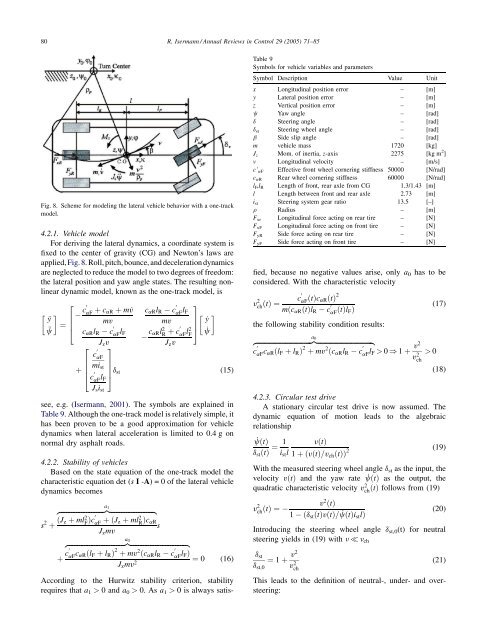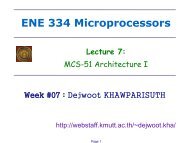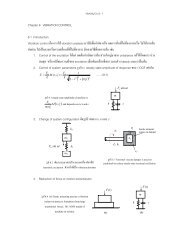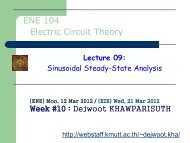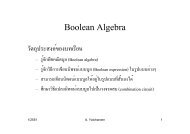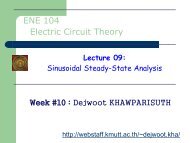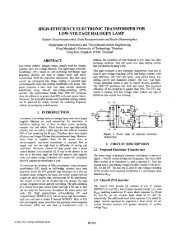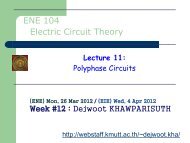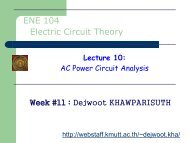Model-based fault-detection and diagnosis ... - web page for staff
Model-based fault-detection and diagnosis ... - web page for staff
Model-based fault-detection and diagnosis ... - web page for staff
Create successful ePaper yourself
Turn your PDF publications into a flip-book with our unique Google optimized e-Paper software.
80<br />
Fig. 8. Scheme <strong>for</strong> modeling the lateral vehicle behavior with a one-track<br />
model.<br />
4.2.1. Vehicle model<br />
For deriving the lateral dynamics, a coordinate system is<br />
fixed to the center of gravity (CG) <strong>and</strong> Newton’s lawsare<br />
applied, Fig. 8. Roll, pitch, bounce, <strong>and</strong> deceleration dynamics<br />
are neglected to reduce the model to two degrees of freedom:<br />
the lateral position <strong>and</strong> yaw angle states. The resulting nonlinear<br />
dynamic model, known as the one-track model, is<br />
2<br />
¨y<br />
¨c ¼<br />
6<br />
4<br />
c 0<br />
aF þ caR þ m˙v<br />
mv<br />
6<br />
þ 6<br />
4<br />
caRlR c 0<br />
aF lF<br />
2<br />
Jzv<br />
3<br />
7<br />
c 0<br />
aF<br />
mist<br />
c 0<br />
aFlF 5 dst<br />
Jsist<br />
caRlR c 0<br />
aF lF<br />
caRl 2 R<br />
mv<br />
þ c0<br />
Jzv<br />
aF l2 F<br />
3<br />
7<br />
5<br />
˙y<br />
˙c<br />
(15)<br />
see, e.g. (Isermann, 2001). The symbols are explained in<br />
Table 9. Although the one-track model is relatively simple, it<br />
has been proven to be a good approximation <strong>for</strong> vehicle<br />
dynamics when lateral acceleration is limited to 0.4 g on<br />
normal dry asphalt roads.<br />
4.2.2. Stability of vehicles<br />
Based on the state equation of the one-track model the<br />
characteristic equation det (s I -A) = 0 of the lateral vehicle<br />
dynamics becomes<br />
a1<br />
zfflfflfflfflfflfflfflfflfflfflfflfflfflfflfflfflfflfflfflfflfflfflfflfflfflffl}|fflfflfflfflfflfflfflfflfflfflfflfflfflfflfflfflfflfflfflfflfflfflfflfflfflffl{<br />
s 2 þ ðJz þ ml2 FÞc0aF þðJz þ ml2 RÞcaR s<br />
Jzmv<br />
þ c0aF<br />
caRðlF þ lRÞ 2 þ mv2ðcaRlR c 0<br />
aFlFÞ Jzmv2 a0<br />
zfflfflfflfflfflfflfflfflfflfflfflfflfflfflfflfflfflfflfflfflfflfflfflfflfflfflfflfflfflfflfflfflffl}|fflfflfflfflfflfflfflfflfflfflfflfflfflfflfflfflfflfflfflfflfflfflfflfflfflfflfflfflfflfflfflfflffl{<br />
¼ 0 (16)<br />
According to the Hurwitz stability criterion, stability<br />
requires that a1 > 0 <strong>and</strong> a0 > 0. As a1 > 0 is always satis-<br />
R. Isermann / Annual Reviews in Control 29 (2005) 71–85<br />
Table 9<br />
Symbols <strong>for</strong> vehicle variables <strong>and</strong> parameters<br />
Symbol Description Value Unit<br />
x Longitudinal position error – [m]<br />
y Lateral position error – [m]<br />
z Vertical position error – [m]<br />
c Yaw angle – [rad]<br />
d Steering angle – [rad]<br />
dst Steering wheel angle – [rad]<br />
b Side slip angle – [rad]<br />
m vehicle mass 1720 [kg]<br />
Jz Mom. of inertia, z-axis 2275 [kg m 2 ]<br />
v Longitudinal velocity – [m/s]<br />
c’aF Effective front wheel cornering stiffness 50000 [N/rad]<br />
caR Rear wheel cornering stiffness 60000 [N/rad]<br />
lF,lR Length of front, rear axle from CG 1.3/1.43 [m]<br />
l Length between front <strong>and</strong> rear axle 2.73 [m]<br />
ist Steering system gear ratio 13.5 [–]<br />
r Radius – [m]<br />
Fxr Longitudinal <strong>for</strong>ce acting on rear tire – [N]<br />
FxF Longitudinal <strong>for</strong>ce acting on front tire – [N]<br />
FyR Side <strong>for</strong>ce acting on rear tire – [N]<br />
FyF Side <strong>for</strong>ce acting on front tire – [N]<br />
fied, because no negative values arise, only a0 has to be<br />
considered. With the characteristic velocity<br />
v 2 c<br />
chðtÞ ¼<br />
0<br />
2<br />
aFðtÞcaRðtÞ mðcaRðtÞlR c 0<br />
aFðtÞlFÞ (17)<br />
the following stability condition results:<br />
a0<br />
zfflfflfflfflfflfflfflfflfflfflfflfflfflfflfflfflfflfflfflfflfflfflfflfflfflfflfflfflfflfflfflffl}|fflfflfflfflfflfflfflfflfflfflfflfflfflfflfflfflfflfflfflfflfflfflfflfflfflfflfflfflfflfflfflffl{<br />
c 0<br />
aF caRðlF þ lRÞ 2 þ mv 2 ðcaRlR c 0<br />
aF lF<br />
> 0 ) 1 þ v2<br />
v2 > 0<br />
ch<br />
(18)<br />
4.2.3. Circular test drive<br />
A stationary circular test drive is now assumed. The<br />
dynamic equation of motion leads to the algebraic<br />
relationship<br />
˙cðtÞ 1 vðtÞ<br />
¼<br />
dstðtÞ istl 1 þðvðtÞ=vchðtÞÞ 2<br />
(19)<br />
With the measured steering wheel angle dst as the input, the<br />
velocity vðtÞ <strong>and</strong> the yaw rate ˙cðtÞ as the output, the<br />
quadratic characteristic velocity v2 chðtÞ follows from (19)<br />
v 2 chðtÞ ¼<br />
v 2 ðtÞ<br />
1 ðdstðtÞvðtÞ= ˙cðtÞistlÞ<br />
(20)<br />
Introducing the steering wheel angle dst,0(t) <strong>for</strong> neutral<br />
steering yields in (19) with n nch<br />
dst<br />
dst;0<br />
¼ 1 þ v2<br />
v 2 ch<br />
(21)<br />
This leads to the definition of neutral-, under- <strong>and</strong> oversteering:


